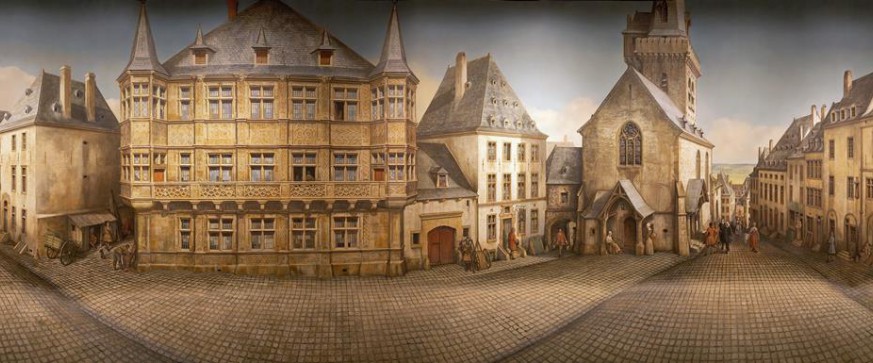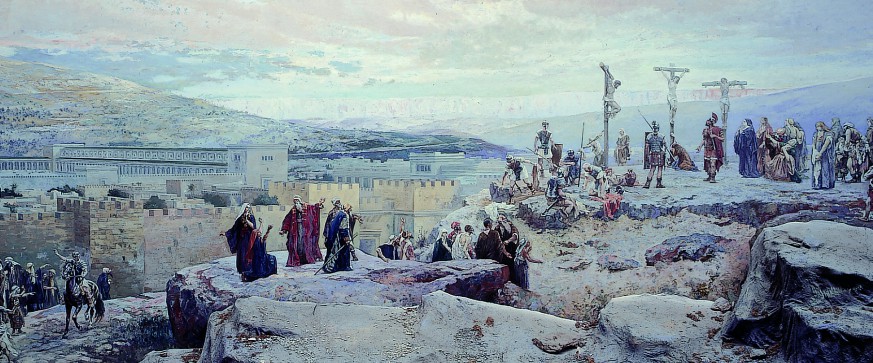The Panorama of the coral reef off the coast of Australia fits in seamlessly with the series of Yadegar Asisi's nature Panoramas. It portrays the unique underwater world of the coral reef in all its fragile beauty and complexity.
- Panorama Rouen 1431
created by Yadegar Asisi in 2016
photo © asisi.jpg)
- Panorama Rotunda by Hittdorf
Paris, France in 1838 - Panorama of the Entry of the Magyars / Feszty-Panorama
Opusztaszer, Hungary
© Patrick Deicher - The City of Luxembourg in the 17th century (Artist: Antoine Fontaine)
Musée d'histoire de la Ville de Luxembourg, Luxembourg
© MHVL, Falk Eisleben
- Semi-circle Panorama 'The Berlin Wall' created in 2012 by Yadegar Asisi, © asisi, Tom Schulze
.jpg)
- e-cyclorama by Sanford Wurmfeld
exhibited in Edinburgh, Scotland in 2008.jpg)
- Jerusalem Panorama Crucifixion of Christ, Altötting, Germany, © Stiftung Panorama Altötting / photo H. Heine
.jpg)
- Wilpena Panorama created by Jeffrey B. Morgan, Hawker, Australia
- Diorama of the Conquest of Constantinople in 1453
Military Museum, Istanbul, Turkey
© Patrick Deicher - ICCI 360 Rotunda
seamless 360° film projection in a mobile rotunda
ICCI (Innovation for the Creative and Cultural Industries) with Plymouth University, UK
© Patrick Deicher.jpg)
- Panorama of Jerusalem and the Crucifixion of Christ, Einsiedeln, Switzerland

- Panorama Raclawice
Wroclaw, Poland
© Patrick Deicher
- Panorama of The Battle of Waterloo
Braine l'Alleud, Belgium
© Patrick Deicher.jpg)
- Interactive electronic panorama
exhibited in Luzern, Switzerland in 2010
© Patrick Deicher.jpg)
- Panorama of the City of Salzburg (Sattler-Panorama)
Salzburg, Austria
- Panorama of the Palace and Gardens of Versailles
Metropolitan Museum of Art, New York, USA
© Patrick Deicher
- Panorama of the Chibi War in 208
Wuhan, China
- Panorama of the Battle of Pleven
Pleven, Bulgaria
© Patrick Deicher
- Panorama of the Battle of Ji Nan
Ji Nan, China
- Panorama of the Battle of Mount Isel
TirolPanorama, Innsbruck, Austria
© Patrick Deicher
- Bourbaki Panorama
Luzern, Switzerland
© Emanuel Ammon.jpg)
- News
Opening of the new Panorama of the Great Barrier Reef
Saturday, 03 October 2015Together with its some 360 hard coral species, the Great Barrier Reef, discovered by James Cook in 1770, forms the largest structure created by living creatures on this planet. It also provides a habitat for numerous other species, including 80 varieties of soft corals and sea pens, over 1,500 species of fish, 1,500 sponges, 5,000 types of molluscs, 800 species of echinoderms (such as starfish), 500 types of seaweed and 215 species of birds.
Six of the seven species of marine turtles in the world are to be found in the Great Barrier Reef. The dugongs (sea cows) living there are an endangered species – as are the marine turtles. Along with other species of whales to be found there, the humpback whales, who live in the Antarctic Ocean, take advantage of the nearby warm waters of the reef to give birth to their young.
The artist Asisi undertook several expeditions to the underwater world of the corals, clown fish, forceps fish, lion fish, marine turtles, starfish, etc. in the turquoise-coloured Pacific Ocean off the Northeast coast of Australia in order to conduct underwater research for his Panorama of the coral reef.
The observer has an underwater view. The fascinating refraction of sunlight in the water provides the major role in producing a dazzling display of colours encompassing the myriad shades of blue, azure and green. It immerses the submarine magical world of corals and sea creatures in bright contrasting tones of yellow, red and pink. By compacting the scene, the Panorama creates an idealised space that in nature would not be recognised in its entirety and at the same time. In the final analysis, this artistic elevating device allows an optimal perception of the coral reef. The blaze of colour and richness of detail of the Panorama also emphasises the uniqueness of creation while simultaneously arguing for its preservation.

.jpg)
.jpg)
